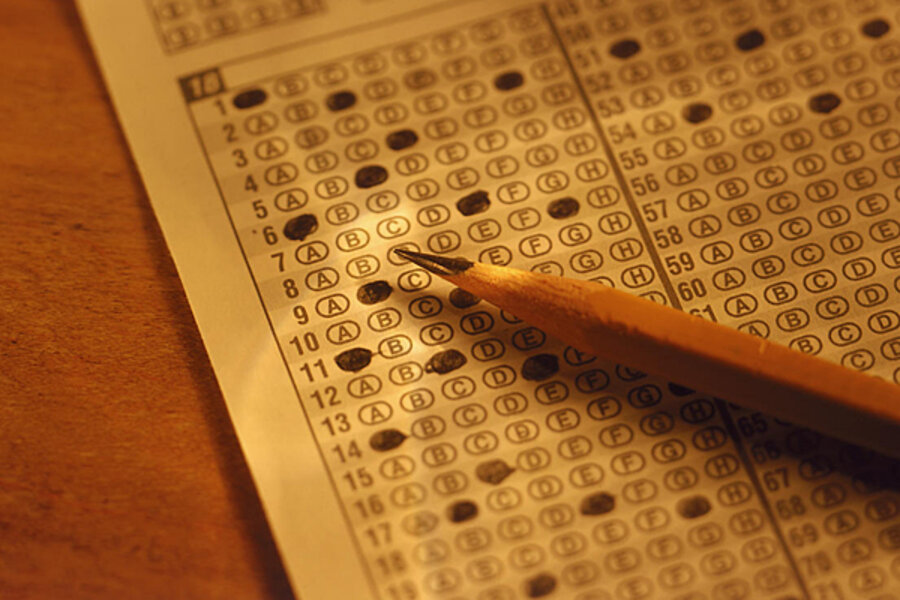Test-score 'bomb': How far is too far in teacher accountability push?
Loading...
Should parents – and everyone else – have the right to see just how much kids’ test scores have changed under individual teachers?
According to the LA Times, the answer is yes.
An analysis the paper has done of just such data – and its plan to publish a database of more than 6,000 third- through fifth-grade teachers later this month, along with their results – has touched off a large debate around the country. It’s the first time such information will be made public for a district.
Already, union leaders have denounced the idea and called for a boycott of the paper, while education officials including Education Secretary Arne Duncan have weighed in to support such transparency. But even some of the biggest advocates of the data – and of using it to evaluate teachers and to make hiring and firing decisions – are critical of the way it’s being used here.
“I’m all in favor of using these tools, but I think it’s way early in the game to be putting individual teachers’ names in the paper with certain scores and suggesting this is a highly informative look at how good a job they’re doing,” says Frederick Hess, director of education policy studies at the American Enterprise Institute.
The data in question is called “value added.” In theory, it’s a way to link teachers with the students they taught and the gains those students made. Since it just looks at growth – not overall proficiency – it should minimize many of the external factors that often affect performance, and focus attention on what contribution the teacher made.
But this is the first time individual teacher performance using value-added data will be made public. Some argue that doing so will send the wrong information about some teachers, making some look better or worse than they are. Others say the public is ill-equipped to understand what the data means and what its limitations are.
“This puts it out to the public before it puts it into the hands of educators and trains them how to use it,” says Paige Kowalski, a senior associate at the Data Quality Campaign, which works with states to get better data systems in place. “To just throw it out there kind of sets it off with a bomb.”
The paper is making teachers’ scores available to them this week and giving them a chance to comment on those scores. In the first article, it highlighted two fifth-grade teachers at the same school – one whose kids tend to make big gains from year to year, and the other whose students lose ground, on average. And it has already published some of larger-scale findings:
- Highly effective teachers regularly bring their students from below grade level to advanced in a single year, and teachers have three times as much influence on students’ learning as which school they attend;
- The best teachers are scattered throughout the district, and the quality of instruction varies more within a school than between schools;
- Teachers’ experience, training, and education have little correlation to how effective they are.
“I don’t think it’s a pinpoint estimate of how teachers are doing, but it’s a reasonable assessment of how successful they are,” says Richard Buddin, a senior economist at Rand Corp., who did the statistical analysis for the Times as an independent consultant. “I understand the criticism…, but these tests are used for a lot of things – which schools are doing well, how students are doing. This is just another way of using them.”
Secretary Duncan has also expressed his support for making this data public.
“What’s there to hide?” he told the Times in an interview. He said that teachers’ effect on kids’ test scores should just be one factor in gauging their success, but added that it "can really empower teachers to strengthen their craft and find out who are the great teachers around them."
California Secretary of Education Bonnie Reiss told the paper that she would encourage more districts to use their data to develop and release value-added scores for teachers.
Teachers, however – many of whom say they would welcome getting such scores privately to help them improve their teaching – seem largely unhappy, and
the local union is outraged.
“We’re playing blame the teacher,” says A.J. Duffy, president of United Teachers Los Angeles, who is calling for the boycott and says he will consider legal options. He dismisses the data as largely useless in measuring the big picture of what teachers do, and notes that standardized tests only cover about 15 percent of the curriculum. “Value-added doesn’t work with human beings, it doesn’t work in an education system,” he says.





